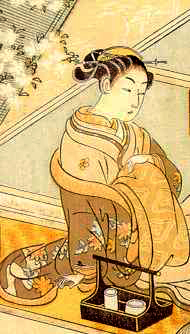Oiran

Oiran (花魁) were high-class courtesans in Japan. The word "oiran" consists of two kanji, 花 meaning "flower", and 魁 meaning "leader" or "first." Cultural aspects of oiran traditions continue to be preserved to this day.
The oiran arose in the Edo period, 1600 - 1868. At this time, laws were passed restricting brothels to walled districts set some distance from the city center. In the major cities these were the Shimabara in Kyoto, the Shimmachi in Osaka, and in Edo (present-day Tokyo), the Yoshiwara. These rapidly grew into large, self-contained "Pleasure Quarters" offering all manner of entertainments. Within, a courtesan's birth rank held no distinction but there arose a strict hierarchy according to beauty, character, educational attainments and artistic skills. Among the oiran, the tayū (太夫 or 大夫) was considered the highest rank of courtesan or prostitute, and were considered suitable for the daimyo. Only the wealthiest and highest ranking could hope to patronise them.
To entertain their clients, oiran practiced the arts of dance, music, poetry and calligraphy, and an educated wit was considered essential to sophisticated conversation.
The isolation within the closed districts resulted in the oiran becoming highly ritualised in many ways and increasingly removed from the changing society. Strict etiquette ruled the standards of appropriate behavior. Their speech preserved the formal court standards rather than the common language. A casual visitor would not be accepted; their clients would summon them with a formal invitation, and the oiran would pass through the streets in a formal procession with a retinue of servants. The costumes worn became more and more ornate and complex, culminating in a style with eight or more pins and combs in the hair, and many prescribed layers of highly ornamented garments derived from those of the earliest oiran from the early Edo period. Similarly, the entertainments offered also were derived from those of the original oiran generations before. Ultimately, the culture of the tayu grew increasingly rarefied and remote from everyday life, and their clients dwindled.
The rise of the geisha ended the era of the oiran. Geisha practiced the common entertainments enjoyed by the people of that time, and were much more accessible to the casual visitor. Their popularity grew rapidly and eclipsed that of the oiran. The last recorded oiran was in 1761. The few remaining women still currently practicing the arts of the oiran (without the sexual aspect) do so as a preservation of cultural heritage rather than as a profession or lifestyle.
Courtesan Parade
The Bunsui Sakura Matsuri Oiran Dōchū is a free event held in Tsubame, Niigata. Dōchū is a shortened form of oiran-dochu, also the name for the walk the top courtesans made around the quarter, or the parade they made to escort their guests. This parade features three oiran in full regalia — Shinano, Sakura, and Bunsui — among the cherry blossoms in April with approximately 70 accompanying servants. Each oiran in 15-cm tall geta sandals parades in the distinctive gait, giving the parade an alternate name, the Dream Parade of Echigo (Echigo no yume-dochu). The event is extremely popular across the country, with many people from all over Japan applying for the three oiran and servant roles of the parade.
In popular culture
- In the Firefly universe created by Joss Whedon, the merging of Asian and Western cultures lead to the creation of the 'Companion' caste, which bears a strong resemblance to both the oiran and to the hetaera.
- In the TV miniseries Shogun, John Blackthorne (Anjin-San) is presented with an oiran as a reward for his faithful service to Lord Toranaga.
- The video game character Setsuka from Soul Calibur III is an amalgamation of an oiran and the Queen of Hearts.
- An oiran was depicted in the movie Sakuran (2007), starring Anna Tsuchiya.
- In the manga and anime series Rurouni Kenshin, a former oiran named Yumi was the lover of one of the primary antagonists, Shishio.
- Also, in the manga and anime series Peacemaker Kurogane, if not working as a shinobi for the Choshu, Akesato is a high-class oiran in the Shimabara district.
